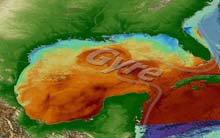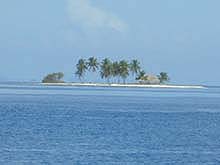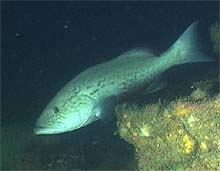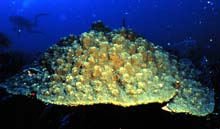
The first segment of the Islands in the Stream expedition focused on the Gulf of Mexico, a region heavily influenced by gyres that disperse animals and plants over great distances. Click image for larger view.
Caribbean and Gulf of Mexico Mission Summary
May 11 - July 13, 2001
The first segment of the Islands in the Stream Expedition was conducted as part of the Sustainable Seas Expedition, a five-year collaborative project between NOAA and the National Geographic Society. Scientists “rode” the Yucatan current from Belize to Mexico to the northern Gulf of Mexico and then south to the Dry Tortugas (Florida Keys). Despite separation across large distances of ocean waters, scientists discovered and documented links between the physical and biological components of these deep water reef systems. Much of the underwater exploration was conducted using the DeepWorker 2000 submersible at depths to 2,000 feet. Below are summaries of the five legs of the mission.
Leg One: Belize, May 12 - May 16
The scientific objectives of this leg were to characterize hard bottom habitats, particularly where fish are known to spawn at predictable periods, and to collect coral and water samples for studying the connections between regional reef systems. Using a combination of scuba dives, shipboard sampling, and nine dives in the Deepworker submersible, scientists collected information at two sites, Gladden Spit and Goff’s Cay, at depths ranging from about 100 feet to over 500 feet.

Small cays (pronounced keys) border Belize's coastline.
On Gladden Spit, mutton snapper, yellowtail snapper, dog snapper, blackfin snapper and barracuda were abundant. Though a relatively high number of individuals were seen for these species, no unusual activity such as spawning or courtship was observed. Thousands of cubera and hundreds of dog snapper were seen spawning and about 10 whale sharks were seen feeding.Planktivores were conspicuously absent in the two areas surveyed. Elsewhere, species like the roughtongue bass, red barbier, and threadnose bass swarmed over deep features. Creolefish, creole wrasse, bogas, blue and brown chromis, and bluehead wrasse were seen over reefs in shallow water.
Leg Two: Mexico, May 17 - May 23
Characterizing hard-bottom habitats, particularly areas with high densities of deep water black coral, and collecting coral, water samples, and data for ancillary studies on the connections between regional reef systems were the major objectives for this leg of the expedition. Scientists conducted eight submersible dives at three sites, Banco Chinchorro, Punta Herradura, and Isla Cozumel at depths from 320 to 515 feet, and also took numerous water samples, carried out fathometer readings, deployed drifter buoys to study currents, clipped fish fins for genetic analysis, and collected video footage during submersible dives.
As in Belize, there was a lack of planktivores in the areas surveyed. Scientists observed low abundance of plankton-feeding fish at Banco Chinchorro as well as numerous empty conch shells along with an absence of living conch. There they collected samples of elkhorn coral, Acropora palmata, and Porites astreoides coral in shallow waters and observed a number of unique species and several that could not be identified.
Leg Three: Flower Garden Banks National Marine Sanctuary
With the exception of one remotely operated vehicle dive, this leg of the mission was scrubbed as a result of a tropical storm Allison.

The Madison/Swanson Fishery Reserve was established to allow gag grouper to recover from low population levels. Gag is one of the dominant economically important reef fish found on the shelf edge. Click image for larger view.
Leg Four: West Florida Shelf, June 11 - June 26
This mission explored and collected quantifiable data from a number of shelf-edge habitat areas in order to compare benthic cover and associated fish fauna among sites. Areas explored were the Pinnacles region (an unprotected area proposed for lease sales for oil and gas exploration), the newly created Madison/Swanson and Steamboat Lumps fishery reserves, and the Florida Middle Grounds Habitat Area of Particular Concern. An additional objective was to explore an area east of the Florida Middle Grounds for signs of drowned river beds that might show signs of human habitation during a time of lower sea level.
During 17 Deepworker descents, scientists logged nearly 70 hours of submersible diving at 15 different sites. At the Pinnacles, efforts to locate a deep-water coral bed of Lophelia discovered in the 1950s was unsuccessful, although clusters of tube worms were encountered at 1800 feet. Among sites visited in Madison Swanson Fishery Reserve were four drowned patch reef sites where grouper aggregate, a high relief paleo-shoreline site known as Stu’s Ridge, an area with relatively high relief pinnacles, and an area thought to have freshwater seeps. Dives in Steamboat Lumps Fishery Reserve concentrated in low relief areas known to be inhabited by over-fished red grouper. On the Florida Middle Grounds, a forty-mile bottom transect was conducted to search for an ancient mouth of the Suwannee River and habitat characterizations were carried out at shelf edge sites.
Leg Five: Tortugas Ecological Reserve, July 1 - July 7

The Tortugas area has the highest coral reef coverage in the Florida Keys.
This mission had multiple objectives, including bottom surveys of two proposed ship anchoring zones; characterizing the geology and benthic habitat of the South Tortugas Ecological Reserve; observing the twilight migration of reef fish from the reef to grass flats; and fish counts in the North Tortugas Ecological Reserve.
At the large ship anchoring zones, scientists evaluated habitat to make sure that large ship anchors and chains would cause minimal damage when lowered and raised. In addition, manatee grass growing at 50 meters was documented for the first time at that depth. New and fascinating discoveries as well as disturbing human impacts were noted at the South Tortugas Ecological Reserve. A large population of gag grouper, a large mola mola, primarily a surface dweller, found swimming on the bottom, discarded trash and fishing gear at 550 meters, and numerous trawl scars were major observations. The study of twilight migration noted how reef fish congregate at the reef edge in the evening for a measure of safety from predators before darting across sand flats to reach the safety of grass beds at night. At the North Tortugas Ecological Reserve, four submersible dives allowed scientists to count reef fish at different locations in order to gage the effectiveness of marine conservation efforts.
Sign up for the Ocean Explorer E-mail Update List.











































